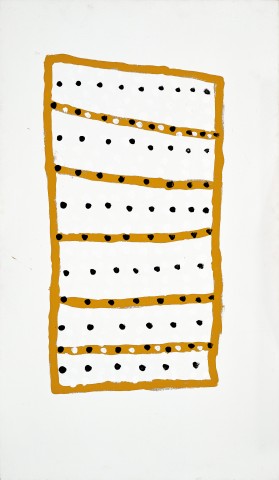BODY MARKS, 2000
PRINCE OF WALES (MIDPUL)
synthetic polymer paint on linen
137.0 x 80.0 cm
bears inscription verso: Karen Brown Gallery cat. KB0892
Commissioned by Karen Brown Gallery, Darwin
Aboriginal Pacific Arts, Sydney
Private collection, New South Wales, acquired from the above in 2000
Deutscher and Hackett, Melbourne, 29 November 2017, lot 48
Private collection, Melbourne
Renowned for his unique interpretations of body decorations and markings used in the ceremonial activities of the Larrakia people, Prince of Wales (Midpul) drew inspiration from these traditional activities for the imagery in his contemporary paintings. Born Midpul at Kah'lin (Cullen) Beach, Darwin in 1935, Prince grew up at Belyuen (Dellisaville), a small community on the far side of Darwin Harbour. He was the son of acknowledged Larrakia leader and traditional land-owner Imabul (Old King George) and known as Prince of Wales. A custodian and leader of Larrakia ceremonies and dances, a leading didgeridoo player and ceremonial body painter for much of his life, Prince started painting, initially on discarded pieces of wood and cardboard in 1995, and participated in his first exhibition the following year.
'In taking up painting in 1995, Prince found a medium through which he could retain the essence of his active ceremonial life. His paintings have a musicality imparted by the lively staccato effect of the dots and intermittent bars, as if to read like sheet music for an improvised symphony. Prince's uninhibited use of colour belies the origins of these designs which were passed on by his ancestors as marks on the bodies of ceremonial participants.'1
Executed on a white ground, Body Marks, 2000 reinforces the ceremonial body decorations that Prince of Wales wanted to preserve in his painting. Alternate white and black dots of the body marks is contained within a bronze-coloured frame that together creates an rhythmic energy within the work. These markings evoke the patterns Prince would have originally painted onto the bodies of his clansmen prior to a ceremonial dance, but here they are transferred as a permanent record for posterity. The work was painted in the final years of his life and as Perkins notes ‘In his last years, Prince ‘upped the ante’, scaling up his Body Marks paintings to assert his cultural authority as a Larrakia elder’2 'These paintings ... I paint them on bodies ... young people and old ... ceremony for singing ... dance ... I make the marks'.3
His first solo show was in Melbourne in 1997 at Gallery Gabrielle Pizzi, and in 2001, he won the painting sections of the Telstra National Aboriginal and Torres Strait Islander Art Award. Prince delighted in the whole process of painting, creating modern minimalist art works characterized by simple geometric forms floating above a sparse ground with dotting emphasizing the forms.
1. Perkins, H., Tradition Today; Indigenous Art in Australia, Art Gallery of New South Wales, Sydney, 2004, p. 166
2. Ibid
3. The artist cited in notes on Prince of Wales and the Gwalwa Daraniki Land Movement, kindly provided by the late Grant Smith of Gallery Gabrielle Pizzi
CRISPIN GUTTERIDGE
